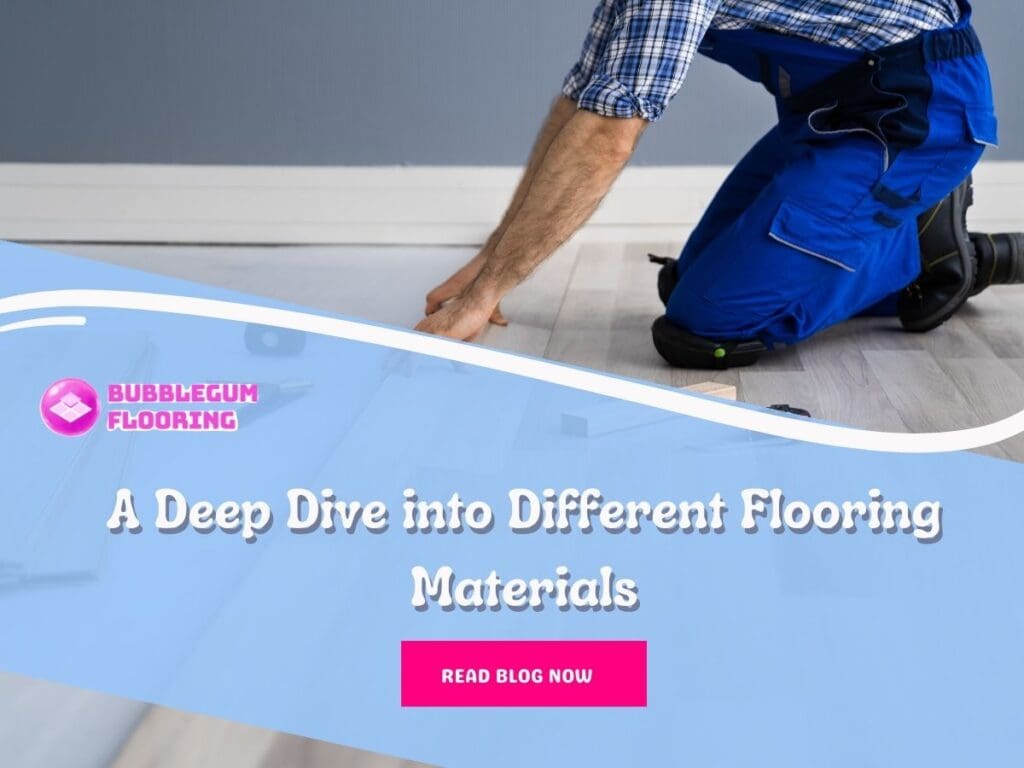A deep dive into different flooring materials is an essential aspect of planning any home or office renovation. The choice of flooring can significantly impact the overall look, feel, and functionality of a space. In this comprehensive blog, we will guide you through various flooring options, examining their characteristics, benefits, and maintenance requirements to empower you with the knowledge needed to make an informed decision that aligns with your style and lifestyle.
From the timeless appeal of classic hardwood to the modern versatility of vinyl, each flooring material has its unique advantages and considerations. Join us on this journey as we unravel the secrets beneath your feet and help you navigate the diverse world of flooring options.
Whether you prioritize aesthetics, comfort, or durability, our exploration of different flooring materials aims to provide you with the insights necessary for a successful and satisfying renovation experience. Let’s step onto this fascinating floor together and discover the perfect fit for your needs!
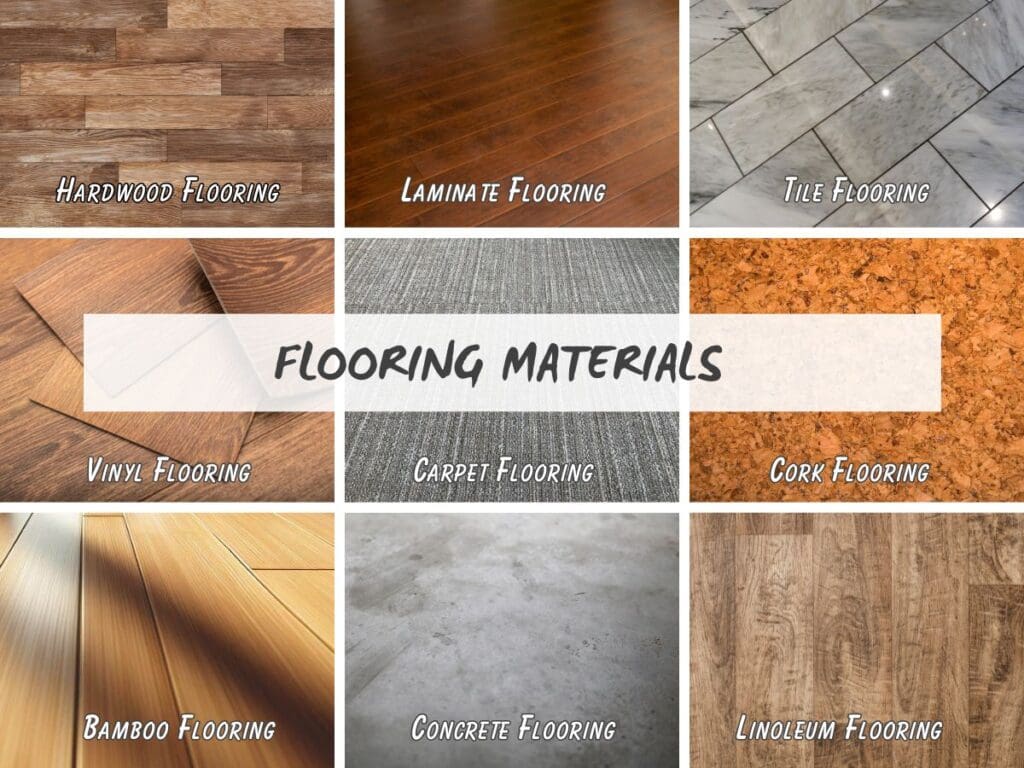
Hardwood Flooring
When it comes to timeless elegance and enduring charm, few flooring options can match the allure of hardwood. It’s a classic choice that has stood the test of time and remains a favorite for homeowners and designers alike.
Hardwood floors are prized for their natural beauty and warmth. The distinctive grain patterns and rich colors of wood provide a warm and inviting atmosphere that can’t be replicated by other materials.
Hardwood is renowned for its durability and longevity. With proper care, hardwood floors can last for generations, making them an excellent investment in your property.
Advantages of Hardwood
- Exceptional aesthetics: Hardwood exudes a timeless and upscale look that complements various interior styles.
- Durability: Hardwood can withstand heavy foot traffic and is resistant to wear and tear.
- Longevity: With regular maintenance, hardwood can last for decades.
Considerations and Maintenance Tips
- Susceptibility to scratches and dents: Consider using rugs or furniture pads to protect your hardwood floors.
- Vulnerable to moisture: Hardwood can warp or swell when exposed to excess moisture, so it’s not suitable for bathrooms or basements.
- Regular maintenance: Periodic refinishing and cleaning are necessary to maintain the luster and condition of hardwood floors.
Style and Design Options
Hardwood offers a wide array of choices, including various wood species and finishes, enabling you to customize your floors to match your aesthetic preferences and interior design. Some popular hardwood species include oak, maple, cherry, and walnut, each with its own unique grain patterns and color variations.
Additionally, there are different finishes, such as matte, semi-gloss, or high-gloss, which can further enhance the appearance of your floors.
In recent trends, wide-plank hardwood flooring has gained popularity for its contemporary and open feel. Mixing hardwood species and creating intricate inlays or patterns are also modern design techniques that allow for creativity and personalization.
Hardwood remains a top contender for those who value a blend of natural beauty, longevity, and design versatility in their flooring choice..
Laminate Flooring
Laminate flooring is known for its versatility and affordability. It’s a synthetic material designed to mimic the appearance of natural wood, stone, or tile. This makes it a popular choice for those seeking the look of expensive materials without the associated costs.
Laminate is also highly resilient and resistant to stains and scratches, making it a practical choice for high-traffic areas. One of its standout features is the ease of installation, often available as a “click-and-lock” system that doesn’t require glue or nails.
Benefits of Laminate
- Cost-effective: Laminate offers the appearance of hardwood or stone at a fraction of the cost.
- Easy installation: The DIY-friendly installation process can save you time and money.
- Resistance to wear and tear: Laminate is durable and doesn’t require as much maintenance as natural materials.
Limitations and Care Guidelines
- Durability limitations: Laminate may not be as durable as hardwood or tile, making it less suitable for very high-traffic areas.
- Moisture concerns: It’s essential to prevent water damage, as moisture can cause the material to warp or swell.
- Limited refinishing options: Unlike hardwood, laminate can’t be sanded and refinished, so damaged planks may need to be replaced.
Style and Design Options
Laminate flooring comes in an array of design options. You can find wood-look laminates that simulate various wood species, from oak to hickory.
Stone-look laminates offer the appearance of natural stone tiles, while creative patterns and textures provide unique design possibilities.Modern trends include distressed or reclaimed wood-look laminates and large-format planks that give spaces a contemporary feel.
Tile Flooring
Tile flooring, which includes ceramic, porcelain, and natural stone variations, is renowned for its adaptability. It is highly resistant to moisture and provides exceptional durability, making it ideal for areas with high humidity or heavy foot traffic.
The variety of materials offers different aesthetics and performance characteristics, enabling homeowners to select the right type for their specific needs.

Advantages of Tile Flooring
- Water resistance: Tiles are impervious to moisture, making them suitable for kitchens and bathrooms.
- Durability: They can withstand heavy wear and are resistant to scratches and dents.
- Low maintenance: Regular cleaning is straightforward, and tiles retain their appearance over time.
Grout Cleaning and Maintenance Considerations
- Grout care: Grout lines between tiles require periodic cleaning and sealing to prevent staining and mildew growth.
- Cold underfoot: Tiles can feel cold, so underfloor heating systems may be needed for comfort.
- Hard and unforgiving: Tiles don’t provide cushioning, so area rugs or mats are often used for added comfort.
Style and Design Options
Tile flooring offers a world of design possibilities. Different tile sizes, shapes, and patterns enable homeowners to create unique, customized looks.
While traditional ceramic and porcelain tiles offer a wide range of colors and designs, natural stone tiles like marble, granite, and slate bring a touch of luxury to interiors. Tiles can be used to create intricate patterns, mosaics, or bold statements, and they’re often chosen for their timeless and elegant appearance.
Vinyl Flooring
Vinyl flooring is a budget-friendly and low-maintenance option that has come a long way in terms of design and durability. It is known for its cost-effectiveness, resilience, and ease of maintenance.
Vinyl can mimic the look of various materials, including wood and stone, making it versatile for different interior styles. Its durability makes it suitable for high-traffic areas, and it’s often chosen for its soft and cushioned feel underfoot.
Benefits of Vinyl
- Cost-effectiveness: Vinyl is one of the most affordable flooring options available.
- Resilience: It can withstand heavy use, making it suitable for family homes and commercial spaces.
- Easy maintenance: Vinyl is simple to clean and doesn’t require special treatments or refinishing.
Environmental Considerations
- VOC emissions: Some vinyl products may release volatile organic compounds (VOCs), so look for low-VOC or phthalate-free options.
- Durability limitations: While durable, vinyl may not match the longevity of materials like hardwood or tile.
- Susceptibility to damage: Sharp objects or heavy furniture can cause tears or dents in vinyl.
Style and Design Options
Vinyl flooring offers various design options to suit your preferences. Vinyl plank, tile, and sheet options provide flexibility in installation and design. Wood-look vinyl planks and stone-look tiles are popular choices, but you can also find vinyl with creative patterns and textures.
The range of colors and styles available allows you to create a custom look that complements your decor.
Bamboo Flooring
Bamboo flooring is a unique and sustainable option gaining popularity due to its eco-friendliness. Bamboo is a rapidly renewable resource, making it an environmentally responsible choice.
It’s also celebrated for its hardness and durability, comparable to hardwood. Additionally, bamboo has a distinct appearance, with natural and carbonized styles offering various shades and grain patterns.
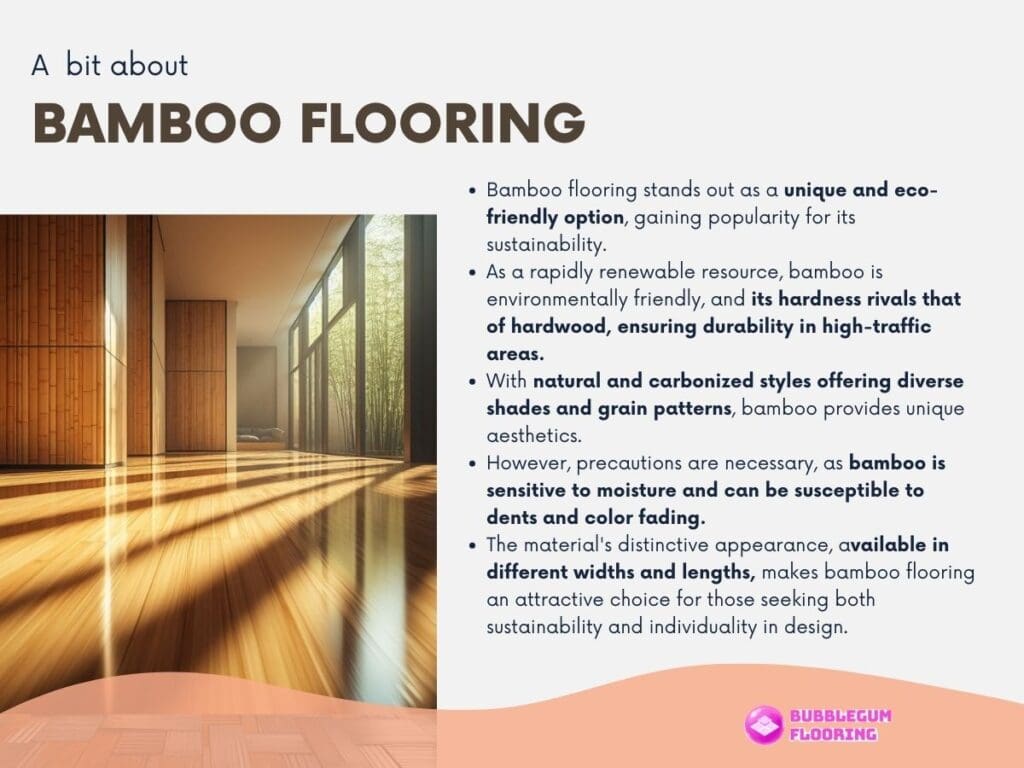
Advantages of Bamboo
- Eco-friendliness: Bamboo is a highly sustainable material, making it an environmentally responsible choice.
- Durability: Bamboo is hard and durable, suitable for high-traffic areas.
- Unique aesthetics: The natural and carbonized bamboo styles offer diverse design possibilities.
Vulnerabilities and Precautions
- Moisture sensitivity: Bamboo can be susceptible to moisture damage, so it’s crucial to maintain a controlled environment.
- Susceptibility to dents: While hard, bamboo can still dent or scratch, so protective measures are advised.
- Potential for color fading: Carbonized bamboo may be more vulnerable to fading with exposure to sunlight.
Style and Design Options
Bamboo flooring presents unique style and design options. Natural bamboo has a light, honey-colored appearance, while carbonized bamboo undergoes a heat treatment process, resulting in a darker, amber hue.
Bamboo planks come in different widths and lengths, allowing for creativity in design. Bamboo’s distinctive look and sustainable characteristics make it an attractive choice for those who appreciate eco-friendly materials with a touch of individuality.
Carpet Flooring
Carpet flooring is a popular and versatile choice known for its comfort, warmth, and aesthetic appeal. It consists of a soft textile surface, usually made from fibers such as nylon, polyester, wool, or a combination of these materials.
Carpeting comes in a wide range of styles, colors, and patterns, allowing homeowners to customize their spaces to suit their preferences.
Advantages
- Comfort and Insulation: Carpet provides a soft and warm surface underfoot, offering insulation and comfort.
- Noise Reduction: It absorbs sound, reducing noise levels and making it an excellent choice for bedrooms or living rooms.
- Versatility in Design: Available in a vast array of colors, patterns, and textures, allowing for versatile design options.
Considerations
- Stain Susceptibility: Carpets can be prone to stains, requiring prompt cleaning to maintain their appearance.
- Maintenance Demands: Regular vacuuming and occasional professional cleaning are essential for long-term durability.
- Not Ideal for Moisture-Prone Areas: Carpets may not be suitable for areas with high moisture levels, such as bathrooms or basements.
Style and Design Options
- Color Variety: From neutral tones to vibrant hues, carpets offer a broad spectrum of color choices.
- Texture Options: Choose from plush, loop, or patterned textures to match the desired aesthetic.
- Pattern and Print: Carpets provide an opportunity to introduce patterns or prints, enhancing the overall design of a space.
Cork Flooring
Cork flooring is an eco-friendly and unique flooring option that has gained popularity for its natural properties and distinctive appearance. It is made from the bark of the cork oak tree, primarily harvested in the Mediterranean region.
The production process is sustainable, as it involves stripping the bark without harming the tree, which then regrows, making cork a renewable resource.
Advantages
- Eco-Friendly: Harvested from renewable cork oak trees, making it a sustainable and environmentally friendly option.
- Comfortable and Resilient: Cork is naturally soft underfoot, providing comfort, and has inherent resilience.
- Resistance to Mold and Mildew: Naturally resistant to mold and mildew, contributing to a healthier indoor environment.
Considerations
- Susceptible to Scratches: While resilient, cork may be vulnerable to scratches, necessitating protective measures.
- Sunlight Exposure: Direct sunlight can lead to fading, so it’s advisable to use window coverings to protect the flooring.
- Moisture Sealing: Proper sealing is crucial, especially in moisture-prone areas, to prevent damage.
Style and Design Options
- Natural Hues: Natural cork colors range from pale honey to rich amber, offering warm and earthy tones.
- Tile or Plank Formats: Available in tile or plank formats, allowing for creative installation patterns.
- Patterned Designs: Some cork options come with unique patterns or prints, adding a touch of individuality.
Concrete Flooring
Concrete flooring epitomizes modern aesthetics, offering a sleek, industrial charm in both residential and commercial spaces. Renowned for durability, it withstands heavy traffic and resists wear, ensuring longevity with proper maintenance.
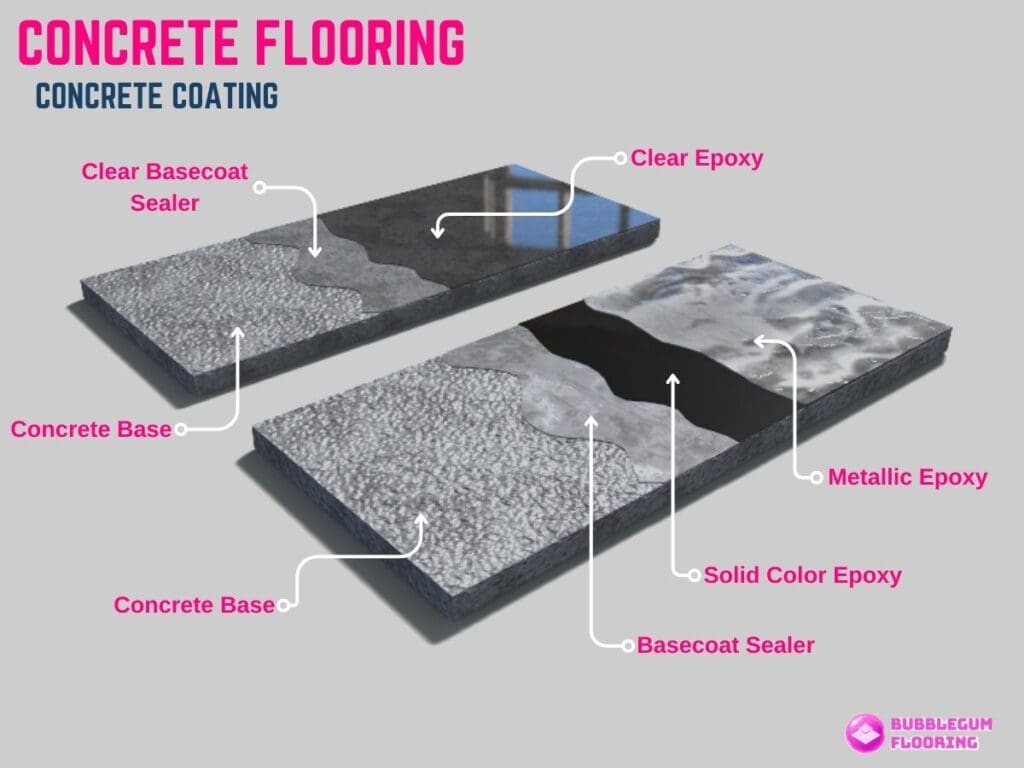
Versatile in finishes, from polished to stained, concrete adapts to diverse design preferences, providing a neutral canvas for customization. Its compatibility with underfloor heating systems enhances energy efficiency and comfort, making it a functional choice for contemporary living.
As a timeless investment, concrete flooring seamlessly blends strength, adaptability, and chic design, embodying a minimalist elegance that aligns effortlessly with evolving interior trends.
Advantages
- Durability: Concrete is exceptionally durable, making it suitable for high-traffic areas and commercial spaces.
- Customizable Finishes: These can be stained, polished, or stamped to achieve a variety of textures and designs.
- Low Maintenance: Requires minimal maintenance, with regular cleaning being generally sufficient for upkeep.
Considerations
- Cold Underfoot: Concrete can feel cold, so the addition of rugs or mats may be desired for added warmth.
- Potential for Cracking: Improper installation or shifts in the foundation can lead to cracks, requiring repairs.
- Limited Cushioning: Lacks the cushioning effect, so it may not be the most comfortable option for prolonged standing.
Style and Design Options
- Stained Concrete: Achieve a variety of colors and patterns through staining techniques.
- Polished Concrete: Offers a sleek and modern look with a reflective surface.
- Stamped Concrete: Mimic the appearance of natural materials like stone or wood through stamping.
Linoleum Flooring
Linoleum flooring, a pragmatic and stylish choice, combines durability with aesthetic versatility. Boasting a broad spectrum of colors and patterns, linoleum effortlessly adapts to diverse design schemes, providing a timeless appeal.
Recognized for resilience, it withstands heavy traffic and resists moisture, making it suitable for high-activity areas. Crafted from eco-friendly materials like linseed oil, wood flour, and cork dust, linoleum promotes sustainability and maintains a hypoallergenic environment.
It’s easy maintenance, requiring only regular sweeping and occasional damp mopping, ensures lasting allure. Overall, linoleum emerges as a durable, environmentally conscious, and visually adaptable flooring solution for a wide range of spaces.
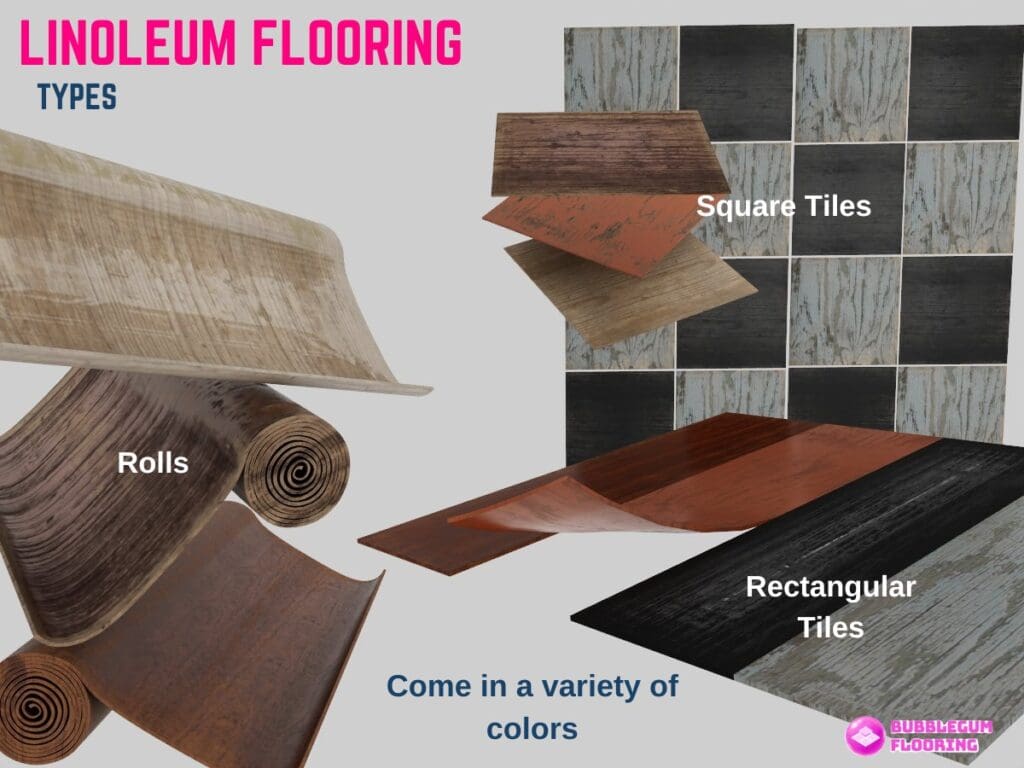
Advantages
- Environmentally Friendly: Made from natural materials like linseed oil and cork, linoleum is biodegradable and eco-friendly.
- Durable: Resistant to scratches and dents, making it suitable for high-traffic areas.
- Color and Pattern Variety: Available in a wide range of colors and patterns, providing design flexibility.
Considerations
- Scratch Susceptibility: While durable, linoleum can still be scratched, requiring some caution in use.
- Occasional Polishing: Periodic polishing may be needed to maintain the glossy appearance of linoleum.
- Moisture Sensitivity: Not recommended for areas prone to moisture, as it can warp or discolor.
Style and Design Options
- Classic Patterns: Linoleum often features classic patterns like checkerboard or herringbone.
- Bold Colors: Choose from an array of vibrant colors to add a lively touch to your space.
- Custom Inlays: Create custom designs or inlays using different linoleum colors for a personalized look.
Conclusion
Flooring choices are diverse, each with unique benefits and considerations. From the timeless elegance of hardwood to the eco-friendliness of bamboo, and the versatility of laminate, tile, and vinyl, there’s a wealth of options.
Understanding their traits and maintenance needs helps make informed decisions. Each material offers distinct advantages, inviting you to choose the flooring that aligns with your style and practical requirements.

